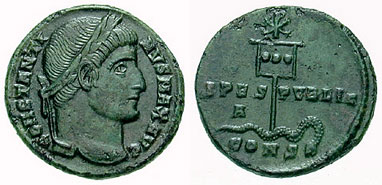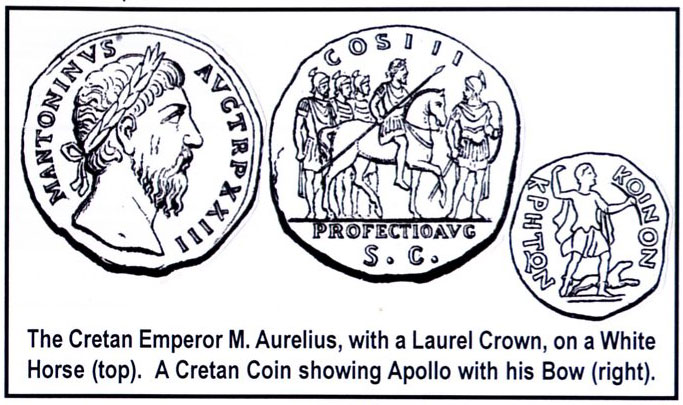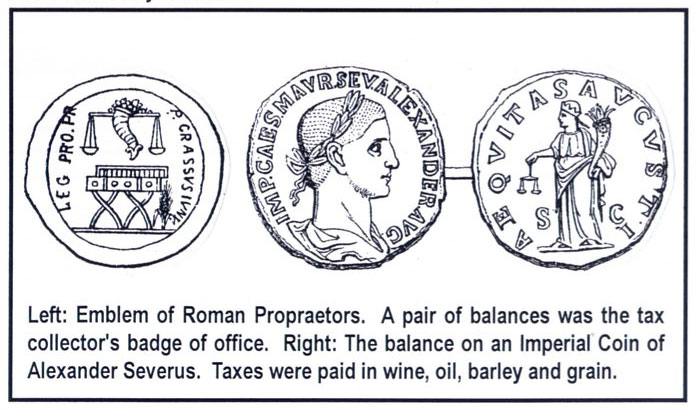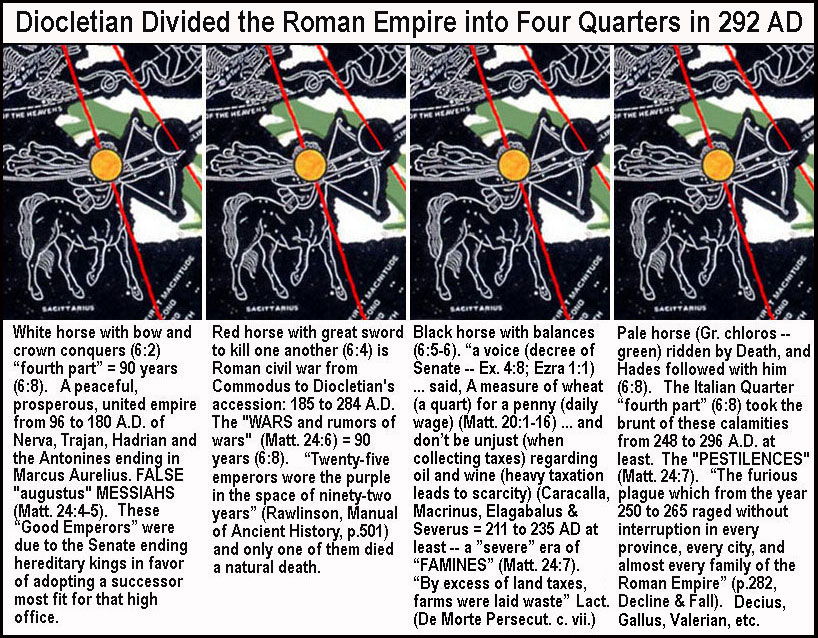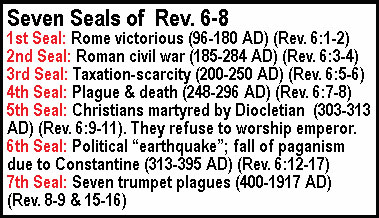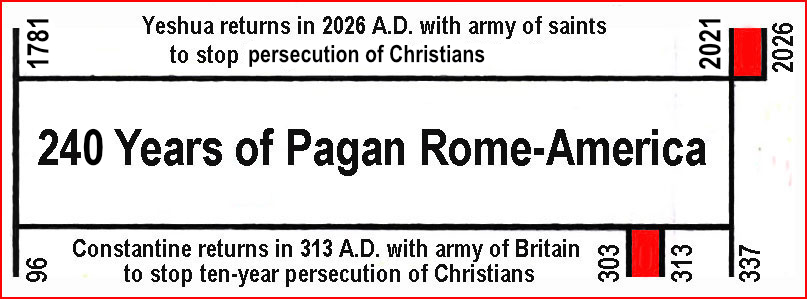
Chapters 5 & 6 Star Chart: This chart portrays "in the right hand of him that sat on the throne (Cepheus) a book written (Milky Way) within (inside the ecliptic) and on the backside (outside the ecliptic), sealed with seven seals" (Moon, Sun, Jupiter, Venus, Mars, Saturn & Mercury) (5:1). Also we see "a lamb (Aries) as though it had been slain" (5:6) -- stabbed by a (red radius line) Roman spear. Aries has "seven horns (two from Aries, two from Taurus, one from Cetus and two from the crescent) and seven eyes" (two from Aries, two from Taurus, two from Cetus, and one solar). We are looking at a graveyard of Christians "slain for the word of God, and for the testimony which they held" (6:9) indicated by the red radius line cross on their grave. From their lunar graves, under the altar (Ara), the martyred constellations ask "How long" till you "avenge our (red radius line) blood?" (6:9-10) The answer is to wait for "their fellowservants" and "their brethren, that should be killed as they were." "And white robes (Milky Way) were given unto every one of them" (6:11). There are two lunar graves -- one from pagan Rome and one from Papal Rome. Sagittarius is a white horse with bow and crown (6:2), a red horse with a "great (red radius line) sword" (6:4), a black horse with "a pair of (moon and sun) scales in his hand" (6:5) and pale (green) horse with the lunar grave pit following (6:8). "And the kings of the earth (Cepheus, etc.), and the great men (Perseus), and the rich men (Orion), and the chief captains (Perseus), and the mighty men (Hercules, Orion), and every bondman (Ophiuchus), and every freeman (Gemini), hid themselves in the dens (crescent moon cave entrances) and in the (sun, moon and star) rocks of the (Milky Way) mountains ; and said to the (Milky Way) mountains and stars (rocks), Fall on us and hide us" (6:15-16).
|
|---|
Chapter 6 -- The Rise and Decline of the Roman EmpireWe have the pre-written history of Europe from chapter 6 to 11 of Revelation. Chapters 12 to 22 give a parallel version of the same history. Revelation 6 begins John's record of the visions he saw as Christ opened, one after the other, the seals binding the scroll. The prophecies then revealed were "shortly to come to pass" (Rev. 1:1), or soon after 96 A.D. As each seal was broken, more of the scroll was unrolled, and Christ translated the written contents into dramatic action before John's gaze. The stage is the "earth" meaning the territory of the Roman Empire. "And I saw when the Lamb opened one of the seals, and I heard, as it were the noise of thunder, one of the four beasts saying, Come and see. And I saw, and behold a white horse: and he that sat on him had a bow; and a crown was given unto him: and he went forth conquering, and to conquer." (6:1-2) When the Lamb opened one of the seals (Astronomically, when Aries kicked the sun seal off the lunar crescent "underneath" with his hoof), I heard one of the four beasts (Taurus -- Victorious Bull-worship or Mithraism) thunder, Come (6:1)(The correct translation is "Come" (RV) not "Come and see" (KJV) since the beast is talking to the horseman, not to John). And I saw a white horse [Astronomically, Sagittarius in daylight; Historically a HORSE symbolizes the ROMAN EMPIRE as ancient Roman coins and war-standards (Pliny HN x16) demonstrate. God led his "house of ISRAEL ... like a HORSE" (Isa. 63:7,13). The "house of JUDAH ... his goodly HORSE in the battle" (Zech 10:3). The horse was dedicated to the War-god Mars and a white horse was always led in triumph into the temple of Mars when the Romans, who claimed to be the offspring of Mars, had their great festivals and celebrations. The Romans engraved the horse and rider on their coins. Roman Israel & Judah are therefore victoriously enjoying Pax Romana; The Roman Empire is largely composed of ISRAELITES at this time. Virgil's Aeneid written in 19 B.C., tells about Trojans under Aeneas who founded Rome. Who were the Trojans? The "TROJANS were called DARDANI" (Lemp. Clas. Dict., p.193). "DARDA" (KJV margin of 1 Chr.2:6) called "DARDANUS" by Josephus, was the Egyptian founder of TROY (and the Kingdom of Priam) on the southern shore of the strait called "DARDANELLES." He was from Judah. And the rider had a bow (lunar crescent combined with Sagittarius's bow making a compound bow; indicating the Cretan dynasty beginning with Nerva since Cretans manufactured the bow); and a crown (solar halo on Sagittarius's head making false "augustus" messiahs -- Matt. 24:4-5) was given to him (Roman augustus; Serpens, the real conquering Roman hero riding Sagittarius with Corona Borealis on his head [alternately a laurel wreathe -- German]) and he went forth conquering (Nerva, Trajan, Hadrian, Antonines & Marcus Aurelius: 96 to 180 A.D. moves from Taurus through Cancer) (6:2). These Roman Caesars counterfeited the "King of kings" who also rides on a white HORSE in ch. 19:11-16. Both riders are kings who demand to be worshipped and both are victorious. But we shouldn't confuse them. One is the sinless Jewish Messiah; the other a series of pagan sinful Roman Jewish "messiahs." "For many shall come in my name (claiming to be "God" or "Augustus"), saying 'I am Anointed'; and shall deceive many" (Matt.24:4-5). The white horse here symbolizes Imperial Rome because Roman emperors invariably rode white horses in their victory celebrations. "Caesar has obtained for us a profound peace. There are neither wars nor battles" (Epictetus, Discourses 3:13:9). Notice: "equos ... candore nivali" (Aeneid 3:537); "Victoriae omen" (Servius Schol.); Cf. Iliad 10:437; Herod. 9:63; Plut. Camillus 7. The national badge of CRETE was a BOW and arrow. The CRETANS manufactured the BOW. The CRETAN Apollo first invented the BOW. Thus Cherethites were David's bodyguard (2 Sam 8:18) and were called "BOW-bearing Cretans" (Pindar Ode 5). Thucydides relates how ARCHERS were fetched from CRETE during the Pelopponesian War by the belligerent parties. All Roman Emperors had been of Italian extraction prior to Nerva. Nerva, the first Emperor of the period, was a CRETAN. The other four emperors who reigned during the age of prosperity were not his descendants, but according to Roman law of adoption were reckoned as such. They were known as the CRETAN dynasty. The rider's "crown" is "stephanos" in Greek meaning a circle of laurel leaves (Greek crown for VICTORS in Pythian games) -- not a jewelled diadem. From 81 A.D. its use was confined to the reigning emperors till 292 A.D. when Diocletian wore a diadem in imitation of barbarian kings. This symbolism is therefore the peaceful, prosperous, united empire from 96 to 180 A.D. of Nerva, Trajan, Hadrian and the Antonines ending in Marcus Aurelius. But it was PAGAN. It did go forth "conquering and to conquer" because Trajan conquered Dacia (Romania) and annexed the kingdom of the Nabateans as the province of Arabia. He temporarily took control of Armenia and Mesopotamia from the Parthians. Hadrian defeated a Jewish rebellion. Marcus Aurelius triumphed over Germans and Sarmatians. The Cretan emperor Marcus Aurelius had a medal struck with him wearing a laurel crown going forth conquering riding on horseback. "In Hebrew the word for 'law' and the word for 'teacher' are both derived from the verb, which means, 'to fire arrows.' Hence, the BOW would appear to the Hebrew mind as a fit symbol for the TEACHER. This idea is illustrated by the following: 'They bend their BOWS to shoot their arrows, even bitter WORDS' (Psa 64:3); 'he bade them TEACH the children of Judah the song of the BOW' (2Sa 1:18)" "And when he had opened the second seal, I heard the second beast say, Come and see. And there went out another horse that was red: and power was given to him that sat thereon to take peace from the earth, and that they should kill one another: and there was given unto him a (red radius line) great sword" (6:3-4). When he opened the second seal (sun seal kicked off of the crescent "underneath" by Aries' hoof), I heard the second beast (Leo -- wild predatory king of beasts) say, Come (6:3). And there went out a red horse (Sagittarius at sunset): and the rider (Roman augustus) took peace from the (Roman) earth, and they killed one another (Roman civil war from Commodus to Diocletian's accession: 185 to 284 A.D. moves from Leo through Libra; "wars and rumors of wars" -- Matt. 24:6): and he was given a great sword (red radius line sword in his hand) (6:4). The sword typified more than bloodshed. The sword was also a symbol of imperial power and authority. The Roman custom was for the emperor to present a sword to the head of the Praetorian guard as a symbol of his authority and swords were also given out to the governors of the provinces (Rom. 13:4). Furthermore, in 183 A.D. Commodus began his rampage ("great sword") against all suspects after an assassin tried to stab him with a "great sword" while shouting that it was "a gift from the senate." Historically, the next stage of Roman history was CIVIL WAR from 185 A.D. (accession of Commodus) to 284 A.D. (Diocletian's accession). During this period there were no less than 32 Emperors opposed by 27 Pretenders (according to Sismondi), who took the "great sword" -- the Roman short sword (Gr. "machaira") -- the red radius line in Sagittarius' hand. Emperor Commodus was ASSASSINATED in 192 A.D. The many armies throughout the empire REVOLTED from allegiance to one emperor, and created numerous rival emperors many of whom were in turn MURDERED. The rival armies under their respective generals in the provinces brought wide-spread CIVIL WAR and REVOLUTION; whole armies MASSACRED one another and red blood drenched the empire. These are the "WARS and rumors of WARS" (Matt. 24:6). Gibbon says of this era, "The power of the sword had begun its reign, and military rule was supreme. The tyranny of Commodus, the civil wars occasioned by his death, and the new policy introduced by Severus, had all contributed to increase the dangerous power of the army, and to obliterate the faint image of laws and liberty that was still impressed upon the minds of the Romans. This internal change undermined the foundations of the empire" (ch. 6). The "giving of the sword" was fulfilled when Commodus exalted Perennis (who aspired to the Empire) to practically despotic authority as Captain of the Praetorian Guards (ch.4, Gibbon). In theory the Praetorian commander represented the Emperor; the action of Commodus transferred in practice supremacy to the army ("great sword") which it wasn't slow to use. Then Septimus Severus (193-211) increased their number to 50,000 and doubled their pay, making the Praetorian Guard a very "great sword", thereby leading to further revolutions and bloodshed. Commodus rapidly degenerated in character after an attempt was made upon his life in 183. He assassinated any people of distinction without pity. In 193 he was strangled to death, and was succeeded by the virtuous Pertinax who endeavoured to repair the damage caused by his predecessor, and to restore peace. But he was prevented by the Praetorian Guard ("great sword"), who, fearing the suppression of their privileges, power and vices, assassinated him. Then they put the Empire up for auction to the highest bidder and Didius Julianus, a vain old senator, gained it by paying £200 to each of the Guards. This aroused the anger of three generals commanding various divisions of the Roman Legions: Clodious Albinus, Pescennius Niger, and Septimus Severus. Each marched on Rome to defend its honour. "The first to reach the capital was Severus, and with his legions, trained in war ("great sword"), he prepared to attack the Praetorian Guard who were soldiers in name only, and were not prepared to contest the issue, nor defend Julianus in the face of the skilled determined warriors of Severus. To appease Severus and his warriors, they beheaded Julianus, and pronounced Severus Emperor. Severus subsequently disbanded the Praetorian Guard, replacing it with his own legions. Meanwhile, the two other generals converged on Rome from different directions. Severus met them each in battle, and successfully defeated both. Whilst he was a ruthless enemy to his foes, he was a just and firm ruler, and under his control, the last eight years of his reign brought greater peace to the Empire. The sufferings of Rome were Divine retribution for the persecutions that had been levelled against Christians during the first Seal. Nobody can harm the people of God, or oppose His Truth with impunity, for precious in the eyes of Yahweh is the death of His saints (Psa 116:15). The distress heaped on Rome during the course of this Seal, avenged the distress Rome had heaped upon Christians during the first Seal. "The wicked" are God's "sword" (Ps.17:13). "And when he had opened the third seal, I heard the third beast say, Come and see. And I beheld, and lo a black horse; and he that sat on him had a pair of balances in his hand. And I heard a voice in the midst of the four beasts say, A measure of wheat for a penny, and three measures of barley for a penny; and see thou hurt not the oil and the wine" (Rev. 6:5-6). When he opened the third seal (sun seal pulled off crescent "underneath" by Aries' hoof), the third beast (Aquarius -- the tax gatherer who pours out wine and oil) said, Come. A BLACK horse (Sagittarius at night or during solar eclipse; BLACK symbolizes FAMINE -- Lam. 5:10; DEPRESSION -- Job 30:25-31, MOURNING -- Lam 4:8; NO RAIN -- Jer. 14:1-6) and the rider (Roman augustus; Scorpio since "I will chastise you with scorpions" -- oppressive tax -- 1 Ki. 12:14) had a pair of balances in his hand (the bow-balances of Sagittarius holding lunar and solar trays suspended by the bow strings making scales; Libra; scales indicating FAMINE -- Ez. 4:16; As Jesus said, "there shall be FAMINES" -- Matt. 24:7) (6:5). And a voice (decree of Senate -- cp. Ex. 4:8; Ezra 1:1) ... said, A MEASURE of wheat (about one QUART) for a penny (daily wage in Roman times) (Matt. 20:1-16 -- "He agreed with the laborers for a PENNY a DAY"; The denarius was the daily pay of a soldier [Tacitus Annals 1:17]), and three measures of barley for a penny; and don't be unjust (when collecting taxes) regarding oil and wine (heavy taxation leads to scarcity) (Caracalla, Macrinus, Elagabalus & Severus = 3rd Seal: 211 to 235 A.D. -- a "severe" era pictured by an empty Crater cup, a scavenging crow named Corvus, and a Virgin gleaning grain) (6:6). Bread eaten by weight is a sign of SCARCITY. The balances were a common symbol in Rome for justice (cp Job 31:6) and commerce and hence were often a badge of the emperor or provincial governors as seen on Roman coins. The rider is a tax-gatherer. What caused this economic depression and famine? Gibbon says of this period, "The animating health and vigor (of the Roman state) was fled; the industry of the people was discouraged by a long series of OPPRESSIONS," and the financial oppression was "a noxious weed of luxurious growth, DARKENING the Roman world with its deadly SHADE" (cp. Hos. 12:7). And "the general FAMINE, which (soon after Philip's death) befell the empire, was the inevitable consequence of the RAPINE and OPPRESSION, which extirpated the produce (wheat and barley) of the present, and the hope of future harvests." The HEAVY TAXATION was the result of reckless extravagance in the reigns of Caracalla and Elagabalus -- dissolute emperors -- who for ten years exhausted the resources of the Empire in supporting the army. TAXES to support the armies, the court and the capital city, could be paid either in money or the equivalent value of produce such as wheat, wine and oil. Roman TAXATION by this official tax gatherer caused black DEPRESSION. There was EXCESSIVE TAXATION from 200 to 250 A.D. It wasn't just a local phenomenon. In 212 A.D., the Emperor Caracalla issued his famous decree extending the "privilege" of Roman citizenship to all free men within the Empire. Such a "favor" carried with it MORE TAXES. This TAXATION to maintain the armies, coupled with the EXTRAVAGANT administration of the Empire, proved to be so burdensome that AGRICULTURE was RUINED, and fertile provinces were LEFT UNCULTIVATED in desolation, ECONOMIC DEPRESSION and gloom. TAXATION was brought to such a pitch that vast tracts of country went OUT of CULTIVATION -- the tiller of soil feeling NO ENCOURAGEMENT to RAISE CROPS merely to hand over to the revenue officer. The extent of the crushing taxation may be gathered from the fact that when a new government took over, taxes were instantly reduced to one thirtieth part of what they were during the reigns of Caracalla and Elagabalus. Alexander Severus came to the throne after the assassination of Elagabalus, and he complied with the Senate's voice "not to be unjust" with regard to wine and oil. In addition, although wheat should be at FAMINE prices owing to the FISCAL EXTORTIONS of the first part of the seal, prices were lowered instead. The prices given for wheat ("one measure for a penny") and barley ("three measures for a penny") enable us to date the prophecy since they are the exact market prices during the reign of Alexander Severus (222-235 A.D.) who frequently said, "Do as you would be done by." The command should be translated "and see thou BE NOT UNJUST with regard to the oil and the wine,"-- that is, when collecting taxes, take only the FAIR EQUIVALENT in PRODUCE. Wine and oil had been HEAVILY TAXED. Severus lowered the taxes, reduced the price of provisions, and the interest on money. But all his efforts to change the color of the horse were inadequate. The previous evils were too deeply planted to be removed in a short time, and the spoiled army became discontented with the economy of Severus who called the revenue collectors "ROBBERS of the provinces." "And when he had opened the fourth seal, I heard the voice of the fourth beast say, Come and see. And I looked, and behold a pale (green) horse: and his name that sat on him was Death, and Hell followed with him. And power was given unto them over the fourth part of the earth, to kill with (red radius line) sword, and with hunger, and with death, and with the beasts of the earth" (Rev. 6:7-8). The first method of killing was by the "sword" (6:8) -- not "machaira" of 6:4, but "rhomphaia" defined as "a LARGE broad sword used by THRACIANS." The emperor who inaugurated this seal was a rude, uncultured "BEAST" of a man, who had gradually risen in the Imperial service on the basis of brute strength. Over EIGHT-FOOT-TALL, this THRACIAN peasant, and undefeated wrestler, was called Maximin who gained the throne in 235 A.D. after Severus was assassinated by the pro-Maximin army. His first act of cruelty as emperor was to have 4000 nobles put to death without a witness, trial, or defence. From 250 to 300 A.D., disastrous WARS raged both within the empire and against enemies on the borders. DISEASE followed the bloodshed. By 248 A.D., Gibbon remarks, "the animating health and vigor (of the empire) were fled" (PALE). Also the ruin of agriculture through excessive taxation brought inevitable FAMINES; and, as civilization waned, the wild BEASTS which multiplied ravaged the inhabitants. During this time there were 39 emperors and not one died a natural death. Virtually all were assassinated. Once Maximin became emperor, commanders, governors and nobles were executed at the slightest accusation. He confiscated taxes for his own use and the use of his army. He stripped temples of gold and silver. This all led to public revolt and civil WAR. Finally Maximin was killed by his troops. The early church historian Eusebius, writing of this period, says, "Death waged a desolating war with two weapons, FAMINE and PESTILENCE ... Men, wasted away to mere skeletons, stumbled hither and thither like mere shadows, trembling and tottering. They fell down in the midst of the streets ... then, drawing their last gasp cried out, HUNGER! ... Some indeed were already the food of the dogs." Gibbon says, "From the great secular games celebrated by Philip to the death of the emperor Gallienus there elapsed (A.D, 248-268) twenty years of shame and misfortune. During that calamitous period every instant of time was marked, every province of the Roman world was afflicted by barbarous invaders and military tyrants ("beasts"), and the ruined empire seemed to approach the last and fatal moment of its dissolution ... FAMINE was followed by epidemical DISEASES, the effect of scanty and unwholesome food. Other causes must, however, have contributed to the furious PLAGUE which, from the year A.D. 250 to the year 265, raged without interruption in every province, every city, and almost every family in the Roman Empire. During some times, five thousand persons died daily in Rome ... So great was the mortality that we might expect that war, PESTILENCE and FAMINE had consumed in a few years the half of the human species." (ch. 10) Arnobius described the state of the Roman Empire in 296 A.D. by saying,"Men complain: There are now sent us from the gods PESTILENCE, DROUGHTS, WARS, SCARCITIES, LOCUSTS ... Were there not wars with wild BEASTS, and battles with LIONS, and destruction from venomous SNAKES before our time?" (He said this because Christians were explaining the calamities as a fulfillment of the 4th Seal.) These are the "PESTILENCES" (Matt. 24:7). The wild "beasts" also represent barbarians in prophecy (Titus 1:12). Goths poured over the northern border. The success of Goths lured others across the borders. Franks attacked Spain in the West, Allemani attacked the northern provinces, whilst Goths ravaged the coasts of Asia Minor, and Persians threatened the East. Sismondi says, "Diocletian put an end to this long period of anarchy. But such a succession of invasions and civil wars, and so much suffering, disorder and crime, had brought the empire into a state of mortal languor from which it never recovered" (pale horse from 234 to 302 = 68 years) Before going further, it is worth noting that national decline in the United States has proceded along these same lines: From 1776 to 1867 the U.S. expanded and conquered territory as a WHITE horse. From 1861 to 1865 came the RED horse of civil war with lingering after-effects. From 1929 to 1939 came the BLACK horse of Great Depression. Then from 1941 to 1945 (W.W. 2), 1950 to 1953 (Korea) and 1964 to 1973 (Viet Nam), etcetera, the PALE horse of death and hell have been the fruit of war. Next came anti-Christian laws: In 1962 the U.S. Supreme Court banned voluntary, public prayer (Engel v. Vitale) and in 1963 voluntary, public Bible-reading in public school (Abington v. Schempp). Since 1963, SAT scores and productivity have plummetted while fornication, crime, suicide and divorce have sky-rocketed. Then came "Waco Texas" adding up to 666 if A=6, B=12, C=18, etc. After 9-11-2001 the Patriot Act was passed and Americans lost their Bill of Rights. "And when he had opened the fifth seal, I saw under the altar the souls of them that were slain for the word of God, and for the testimony which they held: And they cried with a loud voice, saying, How long, O Lord, holy and true, dost thou not judge and avenge our blood on them that dwell on the earth? And white robes were given unto every one of them; and it was said unto them, that they should rest yet for a little season, until their fellowservants also and their brethren, that should be killed as they were, should be fulfilled" (Rev. 6:9-11). When he opened the fifth seal (sun pulled off crescent "underneath" by Aries), I saw under the altar (Ara) the souls slain (entire Zodiac) for God's word, and for the testimony they held (Cepheus, Hercules, Gemini and Orion all hold Bible scrolls) (Diocletian executed Christians for refusing to worship the emperor or sacrifice to pagan gods from 303 till 313 A.D.; martyrdom -- Matt. 24:9) (6:9): And they cried with a loud voice, saying, How long, O Lord, holy and true (Cepheus), dost thou not judge and avenge our (red radius line) blood? (6:10) And white (Milky Way) robes were given them (constellations); and they were told to rest for a little season, until their brethren were killed (pagan and papal martyrs; c. 610 to 1870 A.D.) (6:11). All the constellations (representing souls) are under Ara (the Altar). The horse with a single rider has disappeared because "military emperors" (27 B.C. to 284 A.D.) have now passed away and Israel is moving west. Hitherto the empire had been governed as one unit. But in 292 A.D. Diocletian divided the empire into four parts. Maximian, Galerius and Constantine therefore helped him govern. "Augustus Diocletian" adds up to 666. (D=500 + I=1 + C=100 + L=50 + V=5 + V=5 + V=5 = 666). The three "V"s are from Augustus or aVgVstVs. The "souls" are Christians martyred by pagan Rome. "They shall deliver you up to be afflicted, and shall KILL you; and ye shall be hated of all nations for my name's sake" (Matt. 24:9). The Brazen Altar in the Court of the Temple was the place where priests burnt the carcasses of the sacrificial animals and around which the blood of the animals was sprinkled. These SACRIFICIAL ANIMALS typified CHRIST'S SACRIFICE and therefore the martyrs in this vision must also be CHRISTIANS who SUFFERED at the hands of the same Roman Empire. Leviticus 4:7 says, "Thou shalt pour all the blood ... at the BOTTOM of the altar." The blood of the victims was poured out UNDER the altar. They were "UNDER" the Altar indicating they were UNDER the New Covenant and would have Eternal Life. Their SACRIFICES were well pleasing to God (2 Tim. 4:6). Under the Mosque of Omar, where the Temple once stood, is an underground cave. In the roof of this cave there was a hole which connected with the floor above where the brazen altar stood. Through that hole the blood of victims poured down into the cave. Diocletian looked upon Christians as enemies since Christians refused to fall prostrate and worship the emperor or offer sacrifice to the pagan gods. Also their Bible condemned heathen sacrifices. Hence when Romans offered Christians the alternative of engaging in such heathen ceremonies or of being put to death, multitudes chose public martyrdom and so died literally "for the Word of God, and for the testimony which they held." God is our "Despot", not Diocletian. "Present your bodies a LIVING SACRIFICE" (Rom. 12:1). It was Smyrna's "tribulation for ten days" (years) (2:8-10). DIOCLETIAN published his edict at Nicomedia on February 24, 303 and it lasted until his death. Constantine (West) and Licinius (Balkans) agreed to treat Christians kindly in the Edict of Milan which took place February 313. The Edict of Toleration by Galerius, was issued in 311 in Serdica (now Sofia, Bulgaria) by Roman Emperor Galerius. It officially ended the Diocletianic persecution of Christianity in the East. This was the longest, fiercest and most universal persecution yet. Churches were demolished, Scriptures burnt, Christians put outside the protection of the law, prevented from holding any office, and imprisoned, tortured, and cruelly slain. When Cain slew righteous Abel, Abel's blood cried out to God for justice (Gen. 4:10). When PAGAN Rome slew Christians, the Christians' (red radius line) blood also cried out (Rev. 6:10). "WHITE ROBES" symbolize "RIGHTEOUSNESS" (Rev. 19:8). They were given to the high priests of each province to signify they were vice-regents of the emperor himself. The first group of martyrs were told to "rest yet for a little season" meaning sleep in death "until their brethren should be killed as they were." Their brethren were the second group of martyrs to be killed at the hands of PAPAL Rome. The "day of vengeance" (Jer. 46:10) is coming and God says, "Vengeance is mine; I will repay, saith the Lord" (Rom. 12:19). Two pillars were erected in Spain with the following inscriptions: "Diocletian ... for having extended the Roman Empire in the east and west, and for having extinguished the name of Christians, who brought the republic to ruin" and "Diocletian ... for having adopted Galerius in the east, for having everywhere abolished the superstition of Christ, for having extended the worship of the gods." "And I beheld when he had opened the sixth seal, and, lo, there was a great earthquake; and the sun became black as sackcloth of hair, and the moon became as blood; And the stars of heaven fell unto the earth, even as a fig tree casteth her untimely figs, when she is shaken of a mighty wind. And the heaven departed as a scroll when it is rolled together; and every mountain and island were moved out of their places. And the kings of the earth, and the great men, and the rich men, and the chief captains, and the mighty men, and every bondman, and every free man, hid themselves in the dens and in the rocks of the mountains; And said to the mountains and rocks, Fall on us, and hide us from the face of him that sitteth on the throne, and from the wrath of the Lamb: For the great day of his wrath is come; and who shall be able to stand?" (6:12-17). The "kings of the earth" are Maximian, Galerius, Maximin, Maxentius, and Licinius (AD 304-324). Instead of the second coming (ch.11), John sees terror-stricken people who THINK it is the "day of his wrath." Other similar descriptions of the Day of the Lord occurred at the downfall of Babylon in 539 B.C. (Isa. 13:9-10), destruction of Judah in 604 B.C. (Zeph. 1:14-16; Jer. 4:23-25), the fall of Israel in 721 B.C. (Hos. 10:8) and of Egypt (Ez. 32:7-8). The EARTHQUAKE is political upheaval. It signifies "the REMOVING of those THINGS that are SHAKEN ... that those THINGS which cannot be shaken may REMAIN.... a KINGDOM which cannot be moved" (Heb. 12:27-28). The SUN, MOON and STARS are political leaders. "His THRONE shall endure as the SUN before me, it shall be established ... as the MOON" (Ps. 89:36-37). The "Lord shall punish ... the HIGH ONES ...the KINGS ... Then the MOON shall be confounded, and the SUN ashamed" (Isa. 24:21-23). The Lord's "fury" is "upon all their ARMIES ... all the HOST of HEAVEN (government) shall be dissolved ... fall down" (34:2-4). "Spiritual wickedness in the HEAVENLIES" (Eph. 6:12). "The LIGHT of the wicked shall be put out" (Job 18:5). DIOCLETIAN the "SUN" was eclipsed in 313 A.D. The "MOON" was pagan CLERGY who obtained glory from Diocletian's favor. "STARS" were GENERALS. As Jesus said, "After the tribulation of those days shall the SUN be darkened, and the MOON shall not give its light, and the STARS shall fall from heaven" (Jerusalem destroyed 70 A.D.) (Matt 24:29). Eusebius describes the ruling Roman GOVERNMENT as "celestial powers, the SUN, the MOON and the STARS" (Eccl. Hist. 10:4). The father is SUN or chief ruler, mother is the MOON and children are STARS or subordinate (Gen. 37:9-10). A mighty WIND is an ARMY (Jer. 4:11-13; 49:36; 51:1-2; Dan.7:2-3). A MOUNTAIN is a KINGDOM (Isa. 2:2; Jer. 51:25; Dan. 2:35; Micah 4:1). EARTH is "all flesh" (Gen. 6:11-12). Since the SUN, MOON and STARS were worshipped alongside other heathen gods in the pantheon of Rome, this verse has a double meaning: "Upon their gods also, the Lord executed judgments" (Nu. 33:4) in Pharaoh's Egypt. Diocletian sent Constantius to govern Britain. He married a British woman named Lady Helena, a native of York. She was daughter of Coel, duke of Colchester, in AD 273. Helen was a member of the royal family of Britain, and surpassed all the ladies of her time, in her skill in music and the liberal arts. Their son was called Constantine, and his mother, Helena, appears to have early taught him the Christian faith. Constantius died at York in 306 A.D. The people of Italy, crushed beneath tyranny and misrule, sought Constantine's deliverance. Constantine traveled to Rome to deliver Christianity from Diocletian. Eusebius records that on the eve of battle, he saw at mid-day the two initial letters of Christ in Greek, X (Chi) and P (Rho) in the sky and above them was written in Latin: "In Hoc Signo Vinces" or "By This Sign Conquer." A dream followed in which he was directed to put the cross on his banners if he wished for victory. He did so. This was a small fulfillment of "Then shall appear the SIGN of the Son of Man in HEAVEN" (Matt. 24:29). He put this symbol on his banner or Labarum. In the Battle of "Milvian Bridge" he defeated the army of Maxentius (successor of Maximian) in October 27, 312 A.D. about nine miles from Rome. Maxentius was drowned in the River Tiber while fleeing. Constantine defeated the rival pagan emperors in 313 A.D. and became Emperor himself (324-337 A.D.). Constantine abandoned the dragon standards of the Roman armies and adopted instead "the Sign of the Cross" which seemed to assure him of victory after victory over fear-stricken pagan armies (cp. Isa. 44:28). Constantine issued the Milan Edict in 313 A.D. giving complete tolerance to all religions, including Christians. Later in his rule, he suppressed heathen sacrifices, destroyed pagan temples, and tolerated no other public form of worship than Catholicism. This is why heathenism came to be called "pagan" because it could only be practiced in the "pagi" or villages (Pagus meaning rural) from where we get the word "peasant." He also elevated Catholics to high offices in the State, and displaced pagans. Heathen priests lost their great power over the people. They "fell from heaven." The Roman population thought the Day of Wrath had come but it was just a type and forerunner. "A stone (Constantine's British & Gallic -- Israelite -- troops) ... smote the image upon its feet" (Dan. 2:34). It was more superficial than substantial. Neverthless, Diocletian was so panic-stricken that he died insane in 313 A.D. Maximinian committed suicide. Galerius was smitten in 310 A.D. with an incurable disease. In 311 A.D., softened by suffering, he allowed Christians to rebuild their places of worship. Then he died. After this Maximin was struck with a sudden plague all over his body. He died in 313 A.D. Licinius lost his life in battle against Constantine. Newton quoting Eusebius says, "Galerius, Maximin and Licinius made even a public confession of their guilt, recalled their decrees and edicts against the Christians and acknowledged the just judgments of God and of Christ in their destruction" (p.461, Newton's Dissertations on the Prophecies). These "kings of the earth" experienced "the wrath of the Lamb." Later, Julian the Apostate in 363 A.D. gave orders for the rebuilding of Jerusalem's Temple to disprove the origins of Christianity by strengthening their enemies the Jews. But "horrible balls of fire breaking out near the foundations, with repeated attacks, rendered the place inaccessible to the scorched workmen" (Amm. Marc.). He reigned one year and eight months. While dying from a Persian lance on the battlefield, he cried, "O Galilean, Thou hast conquered." Pagans hid their idols and heathen rites in the dens and caves. As Gibbon says, "The ruin of the pagan religion is described by the Sophists as a dreadful and amazing prodigy, which covered the earth with DARKNESS, and restored the ancient dominion of chaos and of NIGHT" (ch. 28). The pagan Roman Empire had slain over 10 million Christians. When he had opened the sixth seal (sun pulled off crescent "underneath" by Aries), there was a great earthquake (political revolution -- Heb. 12:27-28; Haggai 2:6,21; Isa. 34:2-4; Matt. 24:29); and the sun became black as sackcloth of hair, and the moon became as blood (6:12); And the stars of heaven fell unto the earth (Pagan emperor as well as solar and astrological worship replaced by Catholics), even as a fig tree casteth her untimely figs, when she is shaken of a mighty wind (an army -- Jer. 4:11-13; stars rotated down to horizon) (6:13). And the heaven (throne -- Haggai 2:21-22) departed as a scroll when it is rolled together (Milky Way scroll with the Zodiac stars at one end rotating in a circle); and every mountain (big nation --Micah 4:1; Isa. 2:2) and island (small nation) were moved out of their places (6:14). And the kings of the earth (Cepheus & Coma; e.g. Maximian, Galerius, Maximin, Maxentius & Licinius), and the great men (Orion), and the rich men (Auriga), and the chief captains (Perseus), and the mighty men (Hercules & Ophiuchus), and every bondman (Andromeda & Pisces), and every free man (Aquarius & Bootes), hid themselves in the dens and in the rocks of the mountains (their constellations rotated down behind the horizon) (6:15); And said to the mountains and rocks (stars), Fall on us, and hide us (under the horizon) from the face of him that sitteth on the throne (Cepheus and Sagittarius both represent Constantine from 313 A.D. till 337 A.D. when he died; Chi Rho sign appeared in heaven [Crux & Centaurus]-- Matt. 24:29), and from the wrath of the Lamb (Aries or Constantine) (6:16): For the great day of his wrath is come; and who shall be able to stand (6:17)? The Battle of Chrysopolis or Scutari resulted in the unification of the empire under Constantine, the Roman Sun, as sole emperor protecting the Catholic Church as his lunar bride. In the defeat of Hadrianople, which preceded that of Scutari, Gibbon says that "the greater part of the fugitives who had retired to the mountains" (to conceal themselves until the panic had subsided) "surrendered themselves the next day" (14:4). "The heavens declare the glory of God; the skies proclaim the work of his hands. Day after day they pour forth speech; night after night they display knowledge (using sign language). They have no (verbal) speech, they use no (vocal) words; no sound is heard from them. Yet their voice (sign language) goes out into all the earth, their (picto-graphic) words to the ends of the world." (Ps. 19:1-4). From 96 A.D. till 337 A.D. is 240 years and from the sun seal removed by Aries to the sun "messiah" riding (Sagittarius) is 240° (2/3 of 360). Notice that the lunar open seal near Aries' hoof also corresponds to the lunar crescent in Sagittarius's hand (240°). Just as the pagan Roman Empire rose and fell over a period of 240 years (when Constantine died in 337 A.D.) culminating in persecution of Christians for 10 years till Constantine came, so also the secular United States may rise and fall over a period of 240 years (Declaration of Independence 1781 to 2021) culminating in persecution of Christians till Christ comes. We believe persecution of Christians in the U.S. may have begun in 2021 with Covid vaccines. Denis Rancourt, a top physicist, stated on Jan. 2024, "Covid vaccines caused 17 million deaths worldwide." Many other experts have come to similar conclusions. Constantine (6:2) was a type of Christ in chapter 19. The description of both is similar. But the comparison is only superficial. Constantine did "according to his own will; and exalted himself and magnified himself above all (Constantine was simultaneously Pontifex Maximus of paganism and Chief Bishop of the Catholic Church). Neither shall he regard the (pagan) gods of his ancestors. But he shall "honor the god of fortresses (saints & angels follow the "way of the Eternal" which is "a fortress" -- Pr. 10:29, Sprl; their images are found in shrines and cathedrals and "The bodies of those saints FORTIFY the city" -- Chrysostom, 4th cent.); and a god whom his fathers knew not" (the Pope) (Dan. 11:36-38). Gibbon says, "The first of the Christian emperors was unworthy of that name till the moment of his death." Thus Constantine's kindred were all slaughtered, except Constantius who died a natural death. "The seed of evildoers shall never be renowned. Prepare slaughter for his children for the iniquity of their fathers, that they do not rise, nor possess the land" (Isa. 14:20). "The thing that hath been, it is that which shall be; and that which is done, is that which shall be done" (Eccl. 1:9). God says, "I change not" (Mal. 3:6). He is "the same yesterday, today and forever" (Heb. 13:8). |
Next Lesson: Angles, Saxons, Jutes and Danes Arrive Safely in Britain | Back to Home | Email Us

